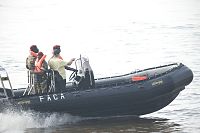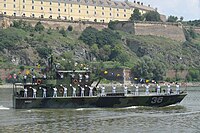
A landlocked country is a country that does not have any territory connected to an ocean or whose coastlines lie solely on endorheic basins. Currently, there are 44 landlocked countries, two of them doubly landlocked, and three landlocked de facto states in the world. Kazakhstan is the world's largest landlocked country, Kyrgyzstan is the furthest landlocked country from any ocean, while Ethiopia is the world's most populous landlocked country.

The South African Navy (SA Navy) is the naval warfare branch of the South African National Defence Force.

A brown-water navy or riverine navy, in the broadest sense, is a naval force capable of military operations in littoral zone waters. The term originated in the United States Navy during the American Civil War, when it referred to Union forces patrolling the muddy Mississippi River, and has since been used to describe the small gunboats and patrol boats commonly used in rivers, along with the larger "mother ships" that supported them. These mother ships include converted World War II-era mechanized landing craft and tank landing ships, among other vessels.

A flotilla, or naval flotilla, is a formation of small warships that may be part of a larger fleet.

The Romanian Naval Forces is the principal naval branch of the Romanian Armed Forces and operates in the Black Sea and on the Danube. It traces its history back to 1860.

The Caspian Flotilla is the flotilla of the Russian Navy in the Caspian Sea.
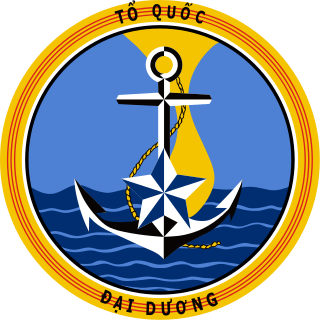
The Republic of Vietnam Navy (RVNN; Vietnamese: Hải quân Việt Nam Cộng hòa - HQVNCH; was the naval branch of the South Vietnamese military, the official armed forces of the former Republic of Vietnam from 1955 to 1975. The early fleet consisted of boats from France; after 1955, and the transfer of the armed forces to Vietnamese control, the fleet was supplied from the United States. With American assistance, in 1972 the VNN became the largest Southeast Asian navy and, by some estimates, the fourth largest navy in the world, just behind the Soviet Union, the United States and the People's Republic of China, with 42,000 personnel, 672 amphibious ships and craft, 20 mine warfare vessels, 450 patrol craft, 56 service craft, and 242 junks. Other sources state that VNN was the ninth largest navy in the world. The Republic of Vietnam Navy was responsible for the protection of the country's national waters, islands, and interests of its maritime economy, as well as for the co-ordination of maritime police, customs service and the maritime border defence force.

The Bolivian Navy is a branch of the Armed Forces of Bolivia. As of 2018, the Bolivian Navy had approximately 5,000 personnel. Although Bolivia has been landlocked since the War of the Pacific and the Treaty of Peace and Friendship (1904), Bolivia established a River and Lake Force in January 1963 under the Ministry of National Defense. It consisted of four boats supplied from the United States and 1,800 personnel recruited largely from the Bolivian Army. The Bolivian Navy was renamed the Bolivian Naval Force in January 1966, but it has since been called the Bolivian Navy as well. It became a separate branch of the armed forces in 1963. Bolivia has large rivers which are tributaries to the Amazon which are patrolled to prevent smuggling and drug trafficking. Bolivia also maintains a naval presence on Lake Titicaca, the highest navigable lake in the world, which the country shares with Peru.

The Azerbaijan Navy is the naval component of the Azerbaijani Armed Forces operating in the Caspian Sea.

The Ethiopian Navy, known as the Imperial Ethiopian Navy until 1974, is the naval branch of the Ethiopian National Defense Force founded in 1955. It was disestablished in 1996 after the independence of Eritrea in 1993, which left Ethiopia landlocked. However, the Ethiopian Navy was re-established in 2019 as a brown water navy and is based in Lake Tana in Bahir Dar, Amhara region.

The Serbian River Flotilla is a tactical brigade-level brown water naval branch subordinated to the Serbian Army of the Serbian Armed Forces. Patroling on the Danube, Sava, and Tisa rivers, it is tasked with environmental policing, counter-terrorism, and border security along country's international river borders.
The Paraguayan Navy is the maritime force of the Armed Forces of Paraguay, in charge of the defense of Paraguay's waters despite not having direct access to the sea.
The Declaration recognising the Right to a Flag of States having no Sea-coast is a 1921 multilateral treaty which legally recognised that a land-locked state could be a maritime flag state; that is, that a land-locked state could register ships and sail them on the sea under its own flag.

The Zhuk-class patrol boat, also known as Project 1400M "Grif", is a small border patrol vessel of less than 40 ton displacement built in the Soviet Union and later in Ukraine. Over 300 boats were built between 1969 and 1991. Out of those, 110 were sold to 23 other countries. Exact numbers are unknown, but they were widely exported by the Soviet Union in addition to use in home waters as harbor patrol. The vessels were excellent for this task thanks to a cheap design for mass production. With only a single simple radar unit and manually-aimed machine guns, they made ideal patrol boats. The dissolution of the Soviet Union in 1991, and the abolition of its primary user the, KGB Maritime Guard, it was taken over by the Russian Federal Coast Guard. By 2007 only 15-20 remained in service with the Russian Navy.
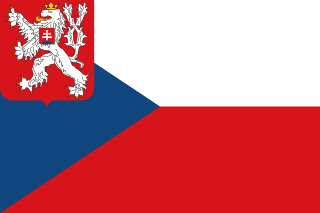
The Czechoslovak Naval Forces were the naval arm of the former Czechoslovak state. Czechoslovakia being landlocked and with no large rivers flowing through it, its naval forces were small and consisted only of riverine craft operating on the Danube.
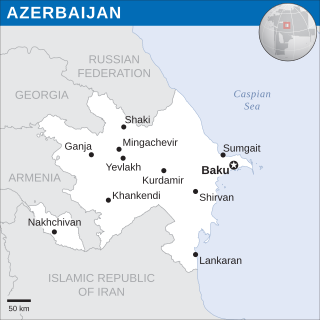
The Borders of Azerbaijan define the land and maritime borders of Azerbaijan. Azerbaijan has international land borders with 5 states.

The Kazakh Naval Forces is the naval force responsible for coastal defense, naval special warfare, and naval warfare branch of the Armed Forces of the Republic of Kazakhstan. The navy mainly operates on the Caspian Sea and is currently based in the coastal city of Aktau.

The Uzbek Navy, known officially as the River Force of Uzbek Frontier Committee are the mobile riverine force of the Armed Forces of the Republic of Uzbekistan, serving under the Border Troops of the State Security Service.
The 4th Region or the Northern Fleet is the flotilla of the Islamic Republic of Iran Navy in the Caspian Sea.








